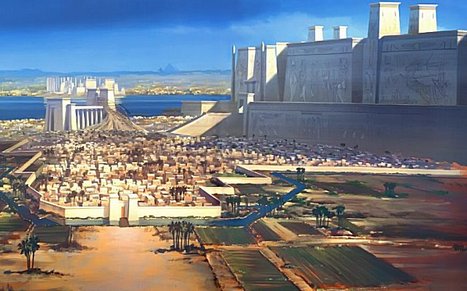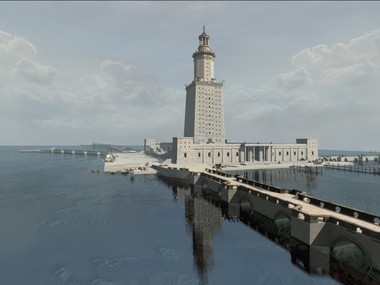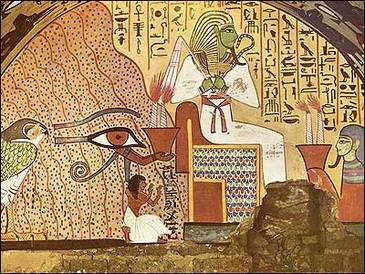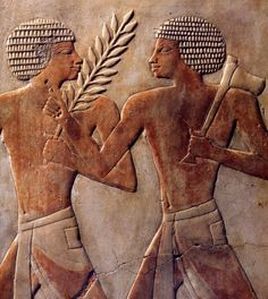Egypt Project Cities

The cities of Ancient Egypt developed along the Nile River due to the fertile farmland along its banks. The typical city had a wall around it with two entrances. There was a major road down the center of the town with smaller, narrow streets connecting to it. The houses and buildings were made of mud-brick. If a building was destroyed in a flood, generally a new building was just built on top of it. Some cities in Ancient Egypt were specialized. For example, there were political towns that housed government workers and officials such as the capital cities of Memphis and Thebes. Other towns were religious towns centered around a major temple. Still other towns were built to house workers for major construction projects like the pyramids. Capital Cities The largest and most important cities in Ancient Egypt were the capital cities. The capital city moved over the course of time. The first capital city was Thinis. Some of the later capitals include Memphis, Thebes, Avaris, Akhetaten, Tanis, Sais, and Alexandria.
Memphis - Entrance Fee = 225 CC
Memphis was the capital of Egypt from 2950 BC to 2180 BC. Some historians estimate that, during its peak, Memphis was the largest city in the world. Memphis continued to be a large and important city in Egypt even after the capital was moved to Thebes. It was also a center of religion with many temples. The main god of Memphis was Ptah, the creator god and the god of craftsmen.
http://www.ancient-egypt-online.com/memphis.html
http://www.touregypt.net/memphis.htm
http://www.ancient-egypt.org/_v3d/ (Click on A-Z, then M, then Memphis - follow links.)
http://www.love-egypt.com/memphis.html
Thebes - Entrance Fee = 225 CC
Thebes first became the capital of Egypt around 2135 BC. It served off and on as capital until around 1279 BC. Thebes and Memphis generally rivaled each other as the largest and greatest cities in Egypt. Thebes was an important political and religious city. It housed several major temples including the Temple of Luxor and the Temple of Karnak. The Valley of the Kings is located near the city of Thebes.
http://www.ancient-egypt-online.com/thebes.html
http://travel.nationalgeographic.com/travel/world-heritage/ancient-thebes/
http://www.ancient.eu/Thebes_(Egypt)/
http://www.africanworldheritagesites.org/cultural-places/ancient-civilisations-of-the-nile/ancient-thebes.html with slide showhttp://www.touregypt.net/featurestories/westbank.htm
Memphis - Entrance Fee = 225 CC
Memphis was the capital of Egypt from 2950 BC to 2180 BC. Some historians estimate that, during its peak, Memphis was the largest city in the world. Memphis continued to be a large and important city in Egypt even after the capital was moved to Thebes. It was also a center of religion with many temples. The main god of Memphis was Ptah, the creator god and the god of craftsmen.
http://www.ancient-egypt-online.com/memphis.html
http://www.touregypt.net/memphis.htm
http://www.ancient-egypt.org/_v3d/ (Click on A-Z, then M, then Memphis - follow links.)
http://www.love-egypt.com/memphis.html
Thebes - Entrance Fee = 225 CC
Thebes first became the capital of Egypt around 2135 BC. It served off and on as capital until around 1279 BC. Thebes and Memphis generally rivaled each other as the largest and greatest cities in Egypt. Thebes was an important political and religious city. It housed several major temples including the Temple of Luxor and the Temple of Karnak. The Valley of the Kings is located near the city of Thebes.
http://www.ancient-egypt-online.com/thebes.html
http://travel.nationalgeographic.com/travel/world-heritage/ancient-thebes/
http://www.ancient.eu/Thebes_(Egypt)/
http://www.africanworldheritagesites.org/cultural-places/ancient-civilisations-of-the-nile/ancient-thebes.html with slide showhttp://www.touregypt.net/featurestories/westbank.htm

Alexandria - Entrance Fee = 225 CC
Alexandria served as the capital city from 332 BC to 641 AD. The city became the capital when Alexander the Great conquered Egypt and one of his generals established the Ptolemy Dynasty. Alexandria remained the capital for nearly a thousand years. In ancient times, the city was famous for the Lighthouse of Alexandria, which was one of the Seven Wonders of the Ancient World. It was also known as the intellectual center of the world and home to the largest library in the world. Alexandria is located in northern Egypt on the coast of the Mediterranean Sea. It is the second largest city in Egypt today.
http://www.ancient-egypt-online.com/alexandria.html
http://www.ancient.eu/alexandria/
http://www.historyworld.net/wrldhis/PlainTextHistories.asp?historyid=aa03
Akhetaten/Amarna - Entrance Fee = 150 CC
Akhetaten was the capital city of Egypt during the reign of the Pharaoh Akhenaten. The pharaoh created his own religion that worshiped the god Aten. He built the city to honor Aten. It was abandoned shortly after Akhenaten died.
http://www.amarnaproject.com/pages/amarna_the_place/index.shtml Be sure to explore the links in the navigation bar at the top of this page
https://en.wikipedia.org/wiki/Amarna
http://www.touregypt.net/featurestories/amarna.htm
Alexandria served as the capital city from 332 BC to 641 AD. The city became the capital when Alexander the Great conquered Egypt and one of his generals established the Ptolemy Dynasty. Alexandria remained the capital for nearly a thousand years. In ancient times, the city was famous for the Lighthouse of Alexandria, which was one of the Seven Wonders of the Ancient World. It was also known as the intellectual center of the world and home to the largest library in the world. Alexandria is located in northern Egypt on the coast of the Mediterranean Sea. It is the second largest city in Egypt today.
http://www.ancient-egypt-online.com/alexandria.html
http://www.ancient.eu/alexandria/
http://www.historyworld.net/wrldhis/PlainTextHistories.asp?historyid=aa03
Akhetaten/Amarna - Entrance Fee = 150 CC
Akhetaten was the capital city of Egypt during the reign of the Pharaoh Akhenaten. The pharaoh created his own religion that worshiped the god Aten. He built the city to honor Aten. It was abandoned shortly after Akhenaten died.
http://www.amarnaproject.com/pages/amarna_the_place/index.shtml Be sure to explore the links in the navigation bar at the top of this page
https://en.wikipedia.org/wiki/Amarna
http://www.touregypt.net/featurestories/amarna.htm

Abydos - Entrance Fee = 150 CC
Abydos is a very old Egyptian city dating back to before the Old Kingdom. The city was considered one of the most holy places in Egypt because it was believed that the god Osiris was buried there. As a result, several temples were built in the city. The most famous surviving building is the Temple of Seti I. Also, some of the first pharaohs of Egypt were buried near Abydos.
http://www.crystalinks.com/AbydosTemples.html
http://www.touregypt.net/featurestories/abydos.htm
http://www.sacred-destinations.com/egypt/abydos
Hermopolis - Entrance Fee = 100 CC
The city of Hermopolis, also called Khmunu, was located on the border between Upper and Lower Egypt. it was a wealthy resort town, but also a center of religion. Egyptian mythology said that the first sunrise occurred over this city. The primary god worshiped here was Thoth.
http://www.touregypt.net/featurestories/hermopolis.htm
http://www.egyptianmyths.net/ogdoad.htm
Crocodilpolis - Entrance Fee = 100 CC
Crocodilopolis was the Greek name for the city of Shedet. It was home to the cult of the crocodile god Sobek. Archeologists believe this city was founded around 4000 BC. Today the city is called Faiyum and it is the oldest city in Egypt. Elephantine - This city was on an island at the border between Nubia and Egypt. The city served as both a defensive fort and a trade center. It was home to the god of the waters, Khnum.
http://egypttrips.blogspot.com/2009/03/crocodilopolis.html
http://ancientstandard.com/2007/07/02/come-to-crocodilopolis-no-we-are-not-making-this-up-3000-%E2%80%93-30-bc/
Abydos is a very old Egyptian city dating back to before the Old Kingdom. The city was considered one of the most holy places in Egypt because it was believed that the god Osiris was buried there. As a result, several temples were built in the city. The most famous surviving building is the Temple of Seti I. Also, some of the first pharaohs of Egypt were buried near Abydos.
http://www.crystalinks.com/AbydosTemples.html
http://www.touregypt.net/featurestories/abydos.htm
http://www.sacred-destinations.com/egypt/abydos
Hermopolis - Entrance Fee = 100 CC
The city of Hermopolis, also called Khmunu, was located on the border between Upper and Lower Egypt. it was a wealthy resort town, but also a center of religion. Egyptian mythology said that the first sunrise occurred over this city. The primary god worshiped here was Thoth.
http://www.touregypt.net/featurestories/hermopolis.htm
http://www.egyptianmyths.net/ogdoad.htm
Crocodilpolis - Entrance Fee = 100 CC
Crocodilopolis was the Greek name for the city of Shedet. It was home to the cult of the crocodile god Sobek. Archeologists believe this city was founded around 4000 BC. Today the city is called Faiyum and it is the oldest city in Egypt. Elephantine - This city was on an island at the border between Nubia and Egypt. The city served as both a defensive fort and a trade center. It was home to the god of the waters, Khnum.
http://egypttrips.blogspot.com/2009/03/crocodilopolis.html
http://ancientstandard.com/2007/07/02/come-to-crocodilopolis-no-we-are-not-making-this-up-3000-%E2%80%93-30-bc/

Kom Ombo - Entrance Fee = 100 CC
Kom Ombo was a trade center where many trade routes passed from Nubia to the rest of Egypt. The city later became famous for the Temple of Kom Ombo. The Egyptians first called the city Nubt, which meant "city of gold."
https://en.wikipedia.org/wiki/Kom_Ombo#History
http://www.egypttravelsearch.net/Cities/Kom_Ombo.html
http://www.ancient-egypt-online.com/kom-ombo.html
Punt - Entrance Fee = 175 CC
The Land of Punt, also called Pwenet, or Pwene by the ancient Egyptians, was an old kingdom. A trading partner of Egypt, it was known for producing and exporting gold, aromatic resins, blackwood, ebony, ivory, and wild animals. The region is known from ancient Egyptian records of trade expeditions to it. Best known in Egyptian history for the trade expedition carried out by Egypt's first female Pharaoh, Hatshepsut.
http://www.ancient.eu/punt/
http://www.pbs.org/wgbh/nova/ancient/egypt-punt.html
http://www.pbs.org/wgbh/nova/ancient/expedition-punt.html
http://www.pbs.org/wgbh/nova/ancient/punt-ship.html (Interactive)
The Lost City: Pyramid Builder's City - Entrance Fee = 175 CC
Pyramid Builders Village:
http://www.bbc.co.uk/history/ancient/egyptians/pyramid_builders_01.shtml
Pyramid Builders Village Interactive Map:
http://www.aeraweb.org/wp-content/themes/custom/map/index.htm
Skip Article - Scroll to bottom and click links to tour Worker’s Village:
http://www.aeraweb.org/projects/lost-city/
Kom Ombo was a trade center where many trade routes passed from Nubia to the rest of Egypt. The city later became famous for the Temple of Kom Ombo. The Egyptians first called the city Nubt, which meant "city of gold."
https://en.wikipedia.org/wiki/Kom_Ombo#History
http://www.egypttravelsearch.net/Cities/Kom_Ombo.html
http://www.ancient-egypt-online.com/kom-ombo.html
Punt - Entrance Fee = 175 CC
The Land of Punt, also called Pwenet, or Pwene by the ancient Egyptians, was an old kingdom. A trading partner of Egypt, it was known for producing and exporting gold, aromatic resins, blackwood, ebony, ivory, and wild animals. The region is known from ancient Egyptian records of trade expeditions to it. Best known in Egyptian history for the trade expedition carried out by Egypt's first female Pharaoh, Hatshepsut.
http://www.ancient.eu/punt/
http://www.pbs.org/wgbh/nova/ancient/egypt-punt.html
http://www.pbs.org/wgbh/nova/ancient/expedition-punt.html
http://www.pbs.org/wgbh/nova/ancient/punt-ship.html (Interactive)
The Lost City: Pyramid Builder's City - Entrance Fee = 175 CC
Pyramid Builders Village:
http://www.bbc.co.uk/history/ancient/egyptians/pyramid_builders_01.shtml
Pyramid Builders Village Interactive Map:
http://www.aeraweb.org/wp-content/themes/custom/map/index.htm
Skip Article - Scroll to bottom and click links to tour Worker’s Village:
http://www.aeraweb.org/projects/lost-city/
